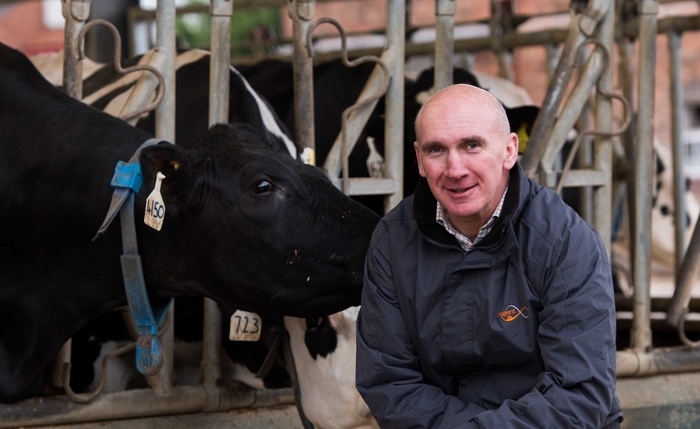A breeding plan using only sexed dairy semen and quality beef semen offers dairy farmers economic, genetic and herd health improvements according to a new industry booklet launched at Dairy Day today, the 12 September, in Telford, Shropshire.
The booklet, titled “The Ultimate Breeding Strategy – Meeting the future supply chain requirements for the profitable dairy herd,” highlights the growing need for dairy farmers to consider the benefits of a new targeted breeding policy.
Contributions from the NFU, Marks and Spencer, Arla Foods UK, AHDB Dairy, The Buitelaar Group, LLM Farm Vets, Kite Consultancy and Cogent illustrate the significant benefits of this new approach to herd reproduction and highlights the role of the breeding policy in meeting the needs of the modern supply chain.
“With an acute need to work closer with the supply chain, increase dairy farm income streams, and protect the highly respected image of the industry, it is time to take a new approach to herd breeding strategy to safeguard dairy farm businesses for the future,” said Mark Roach, managing director of Cogent.
“If you want to remain competitive in the dairy industry, making informed and progressive breeding decisions which maximise the returns from every straw used, is a vital part of your business strategy.
“Working alongside the supply chain, Cogent has invested heavily in research and development to ensure our products are in line with future customer needs. Recent technological advancements within cattle breeding now offer dairy farmers the potential to significantly improve farm returns, through accelerated genetic gains and increased calf values, as well as reducing any issues with selling low value black and white calves.”
Commenting on the need for industry collaboration, Michael Oakes, NFU Chairman of the National Dairy Board said, “We are much stronger as an industry if we develop positive working relationships throughout the supply chain. Retailers and milk buyers want to work with farmers to address sustainability – we must recognise they are part of the solution and by doing so we have a much better chance of success.
“We need to adapt and accept new practices and new technologies that improve efficiencies, whilst maintaining the high level of consumer confidence that we currently experience. In terms of breeding, new technologies have been developed in recent years that have completely changed the landscape of herd reproduction. It’s important we consider how this offers business improvements, in terms of the overall economics, but also consider the supply chain and the new opportunities that it may offer.”
M&S Beef agricultural manager, Tom Slay, added, “For us, sustainable sourcing means working closer with producers than ever before. Looking to the future, we will be exploring opportunities for our dairy group to move towards a breeding programme that uses semen selected to produce heifers and beef semen, aimed at extracting maximum value for the farmer. There are many opportunities for the UK dairy industry. Collaboration will be key to making the most of these opportunities and will require a joined-up approach from everyone in the supply chain.”
Graham Wilkinson, Senior Director of Member Relations at Arla Foods UK, who spoke at the launch, and gave his perspective on how milk marketing has to consider the consumer, “We work closely with our customers and have a thorough understanding of the market in which we operate. It is imperative that we provide consumers with reassurance that our products are produced to high standards. It is vital that we continue to develop our standards and look at new ways of operating in order to retain the trust that consumers have in our products, and to protect our brand integrity.”
Having discussed the importance of consumer and retailer demands for milk marketing, and its place in future farm profitability, the event turned to the subject of calf values. Approximately half of all beef in England is a product of the dairy herd (AHDB Beef and Lamb) and therefore has the potential to be a significant income for dairy farmers.
Adam Buitelaar, managing director of the Buitelaar Group said, “To further maximise returns, dairy farmers should consider income from calves – whether it’s a black and white bull or with a beef bred calf that can generate at least double the price. Dairy farmers now have the tools available to ensure they breed the best replacements for their herd whilst producing consistent and quality calves for the supply chain – resulting in a win:win for their business.”


